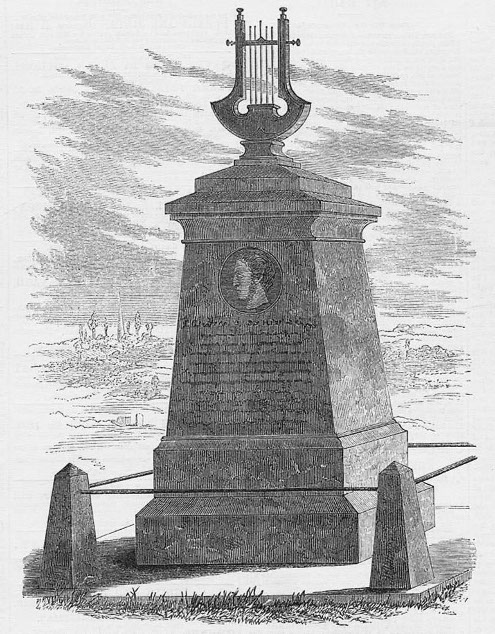HOMEBODY
Sir Henry Bishop

Sir Henry Bishop (1786–1855),
as shown on his monument
If you tend to get maudlin at New Year's Eve and are of a certain age, you might follow 'Auld Lang Syne' with a burst of 'Home, Sweet Home'. If you hear a strange sound afterwards, this could be the song's composer, Sir Henry Rowley Bishop, turning in his grave in East Finchley Cemetery.
Bishop was born in London in 1786 – on the same day as the German composer Carl Maria von Weber, whose path Bishop's was to cross in later years.
Aged twelve, he was selling music in Charing Cross, but he then went to Newmarket to train as a jockey. Being physically unsuited to this, however, he returned to London and studied harmony.
In 1804 his first operatic work, Angelina, was performed at Margate. It was to be followed by nearly sixty others (including The Maniac, or Swiss Banditti and The Brazen Bust ), as well as eleven musical adaptations of the novels of Sir Walter Scott, fifteen arrangements of other operas, and music contributed to plays, other entertainments and other men's operas.
After working at the King's Theatre, Haymarket, in 1810 he became composer and director at Covent Garden, where he ruthlessly doctored works by Mozart and Rossini among others.
Bishop left Covent Garden in 1824, when he was refused a pay rise. A month later Weber was offered the job, and a commission for a new opera, Oberon. When this was premiered, in April 1826, Drury Lane countered with a new Bishop opera, Aladdin. This flopped badly. Weber was present at the premiere, and when a hunting chorus appeared the audience responded by whistling the equivalent from his Die Freischütz.
After five years at Drury Lane, from 1830 to 1833 Bishop was musical director at Vauxhall Gardens, where his second wife (and former student), Ann, became a popular soprano. (Described as 'of the middle size and symmetrically formed', with eyes that were 'large, lustrous and full of fire', in 1839 she ran off and toured the world with a harp-player and reputed forger and bigamist. After his death she married a New York diamond merchant but kept touring, despite once being shipwrecked en route from Honolulu to China.)
Bishop held professorships at London, Edinburgh and Oxford, and in 1842 he became the first musician to be knighted by a British monarch. He died in 1855.
As for 'Home, Sweet Home', it first appeared as a song in his 1823 opera Clari, the Maid of Milan. He had, however, previously published the tune as a 'Sicilian air' when he was short of a tune for a collection of national melodies he was editing, and this quasi-folksong connection led to copyright problems. Donizetti, for example, used a version of the tune in his 1830 opera Anna Bolena, when Anne Boleyn is about to be beheaded; Bishop sued.
The original song was a great favourite with operatic prima donnas. In the singing-lesson scene in The Barber of Seville, Dame Nellie Melba used to have a piano dragged onstage so that she could affectingly sing it to her own accompaniment.
Its appeal has not been quite universal, however. In 1935, in Oklahoma, the lawyer of a defendant accused of bank robbery sang it to try to soften up the jury. His client got life imprisonment.

Sir Henry Bishop's monument as it originally appeared (from the Illustrated News of the World)
Dictionary of National Biography
Grove's Dictionary of Music